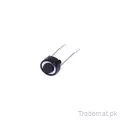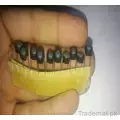Shipping Costs are based on the:
- Product weight
- Shipment weight and volume
Shipment Mode:
- By Air
- By Sea
- By Road
- JazzCash
- Easypaisa
- Bank Transfer
- Cash on delivery
- Visa and MasterCard
- Best price
- 24/7 Support
- Secure Shipping
- Authentic Supplier
- Official Distributor
- 100% Original Products
- Official Brand Warranty
- Different payment methods
Description
Switches don't require any fancy equations to evaluate. All they do is select between an open circuit and a short circuit. Simple. But how could we live without buttons and switches! What good is a blinky circuit with no user input? Or a deadly robot with no kill switch What would our world be without with big red buttons you shouldnever, ever press.
What is a Switch
A switch is a component which controls the open-ness or closed-ness of an electric circuit. They allow control over current flow in a circuit (without having to actually get in there and manually cut or splice the wires). Switches are critical components in any circuit which requires user interaction or control.
A switch can only exist in one of two states: open or closed. In the?off?state, a switch looks like an open gap in the circuit. This, in effect, looks like an?open circuit, preventing current from flowing.
In the on state, a switch acts just like a piece of perfectly-conducting wire. A short. This closes the circuit, turning the system on and allowing current to flow unimpeded through the rest of the system.
A circuit diagram with an LED, resistor, and a switch. When the switch is closed, current flows and the LED can illuminate. Otherwise no current flows, and the LED receives no power.
There are tons and tons of switches out there: toggle, rotary, DIP, push-button, rocker, membrane, the list just goes on and on. Each of those switch types has a set of unique characteristics to differentiate it from others. Characteristics like what action flips the switch, or how many circuits the switch can control. Next up, well go over some of the more basic switch characteristics.
Defining Characteristics
Actuation Method
In order to change from one state to another, a switch must be actuated. That is, some sort of physical action must be performed to flip the switch's state. The actuation-method of a switch is one of its more defining characteristics.
Some examples of switch types.?Push button,?rocker,?slide, and?magnetic.
Switch actuation can come from pushing, sliding, rocking, rotating, throwing, pulling, key-turning, heating, magnetizing, kicking, snapping, licking,?any physical interaction which can cause the mechanical linkages inside the switch to come into, or go out of, contact.
Momentary vs. Maintained
All switches fall into one of two distinct categories: momentary or maintained.
Maintained switches like the light switches on your wall stay in one state until actuated into a new one, and then remain in that state until acted upon once again. These switches might also be called toggle or ON/OFF switches.
Momentary switches only remain active as long as they re actuated. If they re not being actuated, they remain in their off state. You ve probably got a momentary switch (or 50) right in front of you keys on a keyboard!
Semantic alert! Most of the switches we refer to as ?buttons? fall in the momentary category. Activating a button usually means pressing down on it in some manner, which just feels like a momentary control. There are such things as a maintained button, but for this tutorial when we slip and talk about buttons, think momentary push-down switch.
Mounting Style
As with most components, the termination style of a switch always comes down to either surface mount (SMD) or through-hole (PTH). Through-hole switches are usually larger in size. Some might be designed to fit in a?breadboard?for easy prototyping.
These?Tactile buttons?are through-hole and fit perfectly in a breadboard. Great for prototyping!
SMD switches are smaller than their PTH counterparts. They sit flat, on top of a PCB. SMD switches usually require a gentle touch, they're not built to sustain as much switching force as a through-hole switch.
The Arduino Pro has two SMD switches: a?slide switch?for power control, and a?push-button?for reset control.
Panel mount switches ? designed to sit outside an enclosure ? are a popular mounting style as well. It?s hard to flip a switch when it?s hidden inside an enclosure. Panel mount switches come in all sorts of termination styles: PTH, SMD, or heavy-duty solder lugs for soldering to wires.
A panel mounted?illuminated toggle switch.
One more important switch characteristic, which really deserves a page of its own, is the internal circuit arrangement of a switch. Are you looking for an SPST- DPST- 4PDT What-P-what-now?
Features
Reviews
No reviews found






